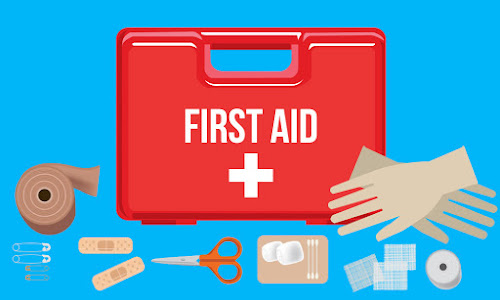First Aid - Aims & Objectives,why have first aid kit,First Aid - Aims & Objective in Physical Education
First Aid - Aims & Objectives
First Aid is the assistance given to any person suffering a sudden illness or injury, with care provided to preserve life, prevent the condition from worsening, and/ or help in promoting recovery.
First aid is the assistance given to any person suffering a sudden injury or illness, and helps in preventing the condition from worsening and helps promoting recovery. First aid is a help given prior to professional medical helps becomes available, giving CPR while waiting for an ambulance, or in some cases applying plaster to a cut.
First aid helps in calming the person so that they don't go into shock, or maintaining a clear air away so an unconscious person does not suffocate.
Thus one can conclude that first aid means too help an injured person before more advanced help/ assistance arrives.
Aims and Objectives
The key aims of first aid can be defined in three key points.
- Preserve Life :- The main aim of all medical care which care which includes first aid, is to save lives and minimize the threat of death.
- Prevent further harm :- Prevent the patient's condition from worsening or danger of further injury. This covers both external factors which help a moving patient away from any cause or injury. One should apply first aid techniques to prevent worsening of the condition such as applying pressure to stop bleeding as excess bleeding can be dangerous.
- Promote recovery :- First aid involves in trying to start the recovery process from the illness or injury and in some cases first aid might involve completing a treatment, as in the case of applying a plaster to a small wound.
Certain first and skills are tangent "ABC" of first aid, whose main aim is to focus on critical life- saving intervention, which must be rendered before treatment of less first be brought to the airway to ensure it is clear. Obstruction (Choking) is a life- threatening emergency. After evaluation of the airways, first aid attendant should determine breathing and provide rescue breathing if necessary. First aiders are new strained to go straight to chest compression and do pulse checks on less serious, patients.
Preserving Life
All persons need to have an open airway, a clear passage where air can move in through the mouth or nose through the pharynx and down into the lungs, without obstruction. People who are unconscious will maintain their own airway automatically controls breathing in normal situations may not be functioning.
It the patient is breathing then the first aider would normally place them in the recovery position the patient lent over on their side, which also helps in cleaning the tongue from the pharynx. This also avoids a common cause of death in unconscious patients is chocking on regurgitated stomach contents.
Sometimes the airway can also become blocked through a foreign object becoming lodged in the larynx or pharynx chocking. The first aider should be taught to deal with through contribution of black slaps and abdominal thrusts.
Promoting Recovery
The first aider should also be trained in dealing with injuries such as cuts, grazes or bone fracture. They may be deal with the situation in the entirely ( a small adhesive bondage on a paper ), or may recognized to maintain the condition like a broken bone, until the ambulance arrives.
Training
To provide effective, life saving first aid interventions requires practical training and instruction. This is also true when it relates to fatal illnesses and injuries, such as those that require ( CPR ) cardiopulmonary resuscitation, the procedures can be invasive, and carry a risk of further injury to the patient and the first aider.
Training is generally provided by attending a course, typically leading to certification.
Contents of First Aid Kit
- First aid manual
- Bandages
- Soap
- Antibiotic Ointment
- Sharp Scissors
- Thermometer
- Flash Light
- Blanket
- Hydrocortisone Cream




Excellent sir👍
ReplyDelete